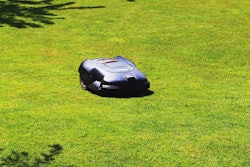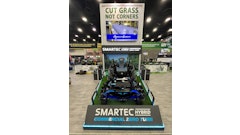
Three manufacturers of robotic mowers—Honda, Husqvarna and STIHL—spoke to Green Industry Pros to weigh in on how automation can assist landscape contractors facing the lack of labor over most of the country. While each machine has its own distinct specifications and features, they also have some common technology and goals between them. In addition, each company believes the robotic mower can be a great tool in helping landscapers stay successful during the labor shortage and sees this moment as an opportunity to change landscapers’ perception of their products.
Brian Manke, a product manager at STIHL Inc., believes that there are more factors at play in the labor shortage than just the H-2B visa. From his perspective, different areas of the country are more likely to feel the effects of the labor shortage than others. “Some areas are experiencing the labor shortage a lot more acutely than others, especially in storm-ravaged areas like Texas. When these big storms come through, a lot of people that used to mow lawns are finding more lucrative careers in installing drywall and repairing houses,” Manke says. And most recently, in the wake of Hurricane Florence, the Carolinas will soon join the ranks of rebuilding.
Steven Uljua, the product manager of robotics for North America at Husqvarna, notes that the robotic lawn mower could help make up that shortfall in human labor, and be the positive difference that makes or breaks a landscape contractor. “This is what the landscapers need right now. They can retain their workforce, even though it’s not what it used to be, because all of the other work still needs to be done—the trimming, the blowing, the hedges,” he says. With the majority of a company’s workforce focused on those duties and other jobs, “They need help mowing the grass,” Uljua states.
Manke agrees, drawing a parallel between the automated mower and the use of robots in manufacturing, “Similar to robotics on the production line, the kind of monotonous task of just mowing back and forth across the lawn can be automated. When you look at the total amount of human labor needed, you can supplement that with a robotic lawn mower.” The human labor once spent on mowing grass can be spent elsewhere on other jobs to keep the landscape contractor profitable.
Elisha Lipscomb, the senior marketing strategist at Honda Power Equipment, also acknowledges that robotic mowers can be an ideal tool to better reallocate human resources for crews that are coming in to maintain yards. While a robotic mower takes care of the task of mowing the lawn, the other landscapers can focus on the rest of the work that needs to get done. Using this method, smaller crews can tackle the same amount of lawns in the same amount of time or quicker, she believes.
On the Wire
While each company has its own robotic mower with specific features (Honda’s Miimo, Husqvarna’s Automower and STIHL’s iMow), some technology between the mowers, such as their basic functions and navigational systems, are similar. For example, each mower works with a buried line or boundary wire.
Manke explains why a robotic mower must use boundary wires instead of GPS. “All robotic lawn mowers work on a boundary wire. Of course, everybody says, ‘Well, why doesn’t it just use GPS?’ because we’re all used to GPS in our cars, and we think it’s super accurate and works really well. GPS in your car only has to place you on the road. It’s not too hard for the GPS system to figure out if you’re on a road or not, but if you’re in a yard, a few inches could be the difference between going around a flower or a tree, or mowing it down,” he says.
Manke says it’s a common misconception that GPS is precise enough to use in a robotic mower, but with the technology as it stands today, using the boundary wire is “the only way to make it exact.” He adds that yards not only have trees and other landscaping, but other houses nearby as well, all of which can disrupt the GPS signal.
While homeowners or landscape contractors may be concerned about the extra upfront cost of installation, Uljua explains that the process is a one-time expense that pays for itself over time. “The boundary wire is installed with a cabling machine,” he says. “The average install is two to three hours, and the cost of the wire is not that expensive.”
As with any shift toward automation, the upfront cost of robotic equipment is a concern. According to Davis Adams, the communications manager at Honda Power Equipment, “At first, it sounds like a fair amount of money, but then you look at the fact that there’s very little maintenance. It’s battery-powered, so there’s obviously no oil to change or gas to worry about. It’s ideal for customers looking for that convenience and flexibility,” he says. “The return on investment could very well be time spent with their family,” Adams concludes.
Furthermore, proper installation of the boundary and guide wires is key for any robotic lawn mower. “It doesn’t matter how well we build the product or how good the quality is,” Manke says. “If it’s not installed right, it won’t work correctly.”
Each Robotic Mower Is Unique
While each robotic mower model relies on some of the same technology, their features vary for each manufacturer. For example, Husqvarna’s Automower is able to learn the property over time. According to Uljua, “Every time it goes out and mows, it’s learning” and taking into account the different features of the lawn. The Automower also has a weather timer, which helps it determine if the lawn needs to be mowed. If mowing is unnecessary, the mower docks itself and sends a notification to the owner.
Husqvarna is also hard at work on an application called Fleet Services, which allows landscape business owners to locate and manage all of their equipment on their phone. “I can keep track of my machines and I don’t have to visit every location to find out what’s going on. Adding Fleet to this now opens up a whole new way of looking at landscaping,” Uljua says.
Additionally, the Automower is able to cover a lot of ground on its own. “We’re starting to get into residential neighborhoods where there are many homes all together in a very close area and right now we have one machine mowing eight homes,” Uljua states.
Robotic mowers like the Honda Miimo offer benefits beyond simply cutting grass, including fertilization. “Since they cut little snippets of grass each time, they actually act as a fertilizer, breaking down those clippings into the root system of your lawn, providing a better quality and better looking lawn over time,” Lipscomb says. “It is a more uniform cut and, over time, the grass is more lush and thicker because it’s being fertilized essentially all the time.”
One of the biggest benefits Manke sees from using the STIHL iMow is also the appearance of the turf. “I can’t stress this enough, but there is a look that you get with a robotic lawn mower that just can’t be matched with a traditional mower because, when a robotic mower is set up properly, and it’s all dialed in and working the way it’s supposed to, the grass looks exactly the same every day,” he says. “It looks perfect.”
Uljua thinks that the green industry’s attitude toward robotic mowers is changing now due to the labor shortage. “The landscape industry looked at robotics as a threat to its way of life. Now, two years later, with the huge shortage in the workforce, it’s looking to us as the cure because the Automower, in its most simplistic form, just mows grass, which frees up labor and provides new opportunities,” he says.
It’s clear that robotic mowers could play an important role in the labor shortage. Manke believes their use could not only help fill current labor needs, but also eventually create even more jobs. “I think as manufacturing moved toward using more robotics, we needed more people to build the robots and maintain them,” he says. “As we move to using more robotic mowers, yes, we are going to need less labor hours, but we are going to need more people who have the technical understanding to be able to install and maintain these pieces of equipment. There is more work to be done than there are people to do it; robotic mowers are just another tool to help get the job done,” he concludes. ❯
Angie Mellor teaches communications and writing classes at Western Technical College in La Crosse, Wisconsin, while freelance writing and editing.
















![Gravely Pro Turn Mach One My23 Dsc03139 Edit 1200x800 5b2df79[1]](https://img.greenindustrypros.com/mindful/acbm/workspaces/default/uploads/2025/10/gravely-pro-turn-mach-one-my23-dsc03139-edit-1200x800-5b2df791.BucBnDoN22.jpg?ar=16%3A9&auto=format%2Ccompress&fit=crop&h=135&q=70&w=240)




